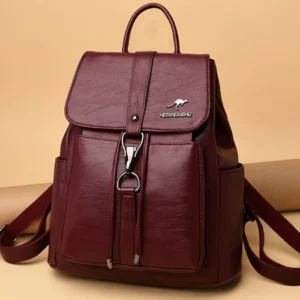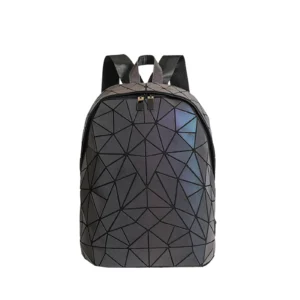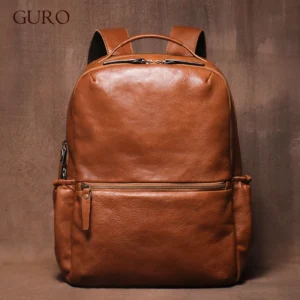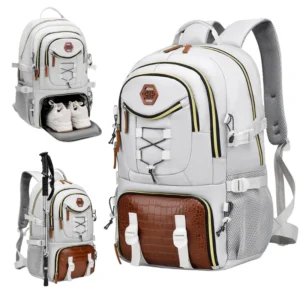Introduction: Understanding Leather Durability Fundamentals
When investing in a leather bag, durability is often at the top of the priority list. But what exactly makes leather durable? In simple terms, leather durability comes from a combination of strength (resistance to tearing), resilience (ability to return to original shape), and resistance to wear (how it handles daily friction and stress).
For bags specifically, durability matters more than in many other leather applications. A good leather bag is an investment that should serve you faithfully through daily commutes, travel adventures, and professional settings. Unlike disposable fashion items, quality leather bags are designed to last years—even decades—becoming more beautiful with age rather than wearing out.
Several key factors determine how durable your leather bag will be:
- The leather’s grain structure (where in the hide it comes from)
- How the leather was tanned and treated
- Which animal the hide came from
- The thickness and weight of the leather used
In this comprehensive guide, we’ll explore these factors in depth, helping you understand the differences between full-grain vs top-grain leather and other options. By the end, you’ll have the knowledge to select the perfect durable leather for your next bag purchase.
- The right leather can last 10-20 years or more with proper care
- Quality leather actually improves with age, developing character and patina
- Understanding leather types helps you make better long-term investments
- Durability varies significantly between different leather grades and tanning methods
Full-Grain Leather: The Gold Standard for Enduring Bags
Full-grain leather represents the pinnacle of leather quality and durability. This premium material comes from the outermost layer of the hide, keeping the entire grain layer intact with its natural surface characteristics, including pores, scars, and markings that tell the story of the animal’s life.
What makes full-grain leather exceptionally durable is its unaltered fiber structure. The densely packed natural fibers create a tough, resistant surface that stands up to years of use. These intact fibers retain the hide’s natural oils, contributing to both strength and flexibility. In practical terms, full-grain leather can withstand up to four times more abrasion than corrected leathers before showing signs of wear.
When examining full-grain leather, look for its distinctive tight grain pattern and natural imperfections. These marks—far from being flaws—are hallmarks of authenticity. Over time, full-grain leather develops a rich patina, becoming more beautiful rather than deteriorating. This aging process creates a unique character that makes each bag one-of-a-kind.
Full-grain leather backpacks are ideal for everyday carry items, travel bags, and professional briefcases where durability is paramount. Premium brands like Summit Carry prioritize full-grain leather precisely because of its unmatched longevity.
Pros:
– Exceptional longevity (can last decades with proper care)
– Develops beautiful character and patina over time
– Highest tensile strength of any leather type
– Natural water resistance that improves with conditioning
Cons:
– Higher initial cost than other leather types
– Natural marks and variations may not suit those wanting a uniform look
– Requires regular maintenance to preserve quality
– Typically heavier than processed leathers
The investment in a full-grain leather bag pays dividends over time, as the material continues to develop beautiful patina while maintaining its structural integrity long after lesser materials would have failed.
Top-Grain Leather: Balancing Refinement and Durability
Top-grain leather represents the second-highest quality tier in the leather hierarchy. Created by sanding or buffing away the uppermost layer of the hide, top-grain leather offers a more uniform appearance than full-grain while still retaining good durability characteristics.
This process removes many of the natural imperfections and creates a smoother, more consistent surface. While this processing does sacrifice some durability (by removing the densest fiber structure), top-grain leather still offers excellent strength and longevity. The typical thickness for top-grain leather used in quality bags ranges from 4-6 oz (1.6-2.4 mm), providing a good balance of strength and flexibility.
Aesthetically, top-grain leather has a more refined look with fewer visible natural markings. This makes it popular for professional bags, luxury handbags, and situations where a cleaner appearance is desired. As it ages, top-grain leather will develop some patina, though not as profound as full-grain leather.
Many popular bag styles benefit from top-grain leather’s balanced properties. Messenger bags, slim briefcases, and structured handbags often utilize top-grain leather to achieve a sleek appearance without sacrificing too much durability.
Understanding where top-grain fits in the hierarchy of leather grades is essential for making informed purchasing decisions. It represents a middle ground—not as durable as full-grain but significantly more durable than genuine or bonded leather options.
Genuine Leather: Understanding Its Limitations
Despite its authentic-sounding name, “genuine leather” is actually a lower grade product in the leather quality hierarchy. This terminology often confuses consumers who reasonably assume “genuine” means “authentic” or “high-quality,” when in reality, it indicates a specific grade of leather made from the split layers beneath the top grain.
Genuine leather is created from these lower, weaker layers of the hide that have been split away from the stronger top sections. These layers are then processed, dyed, and finished to create a usable material. Because these lower layers lack the dense fiber structure of the upper portions of the hide, genuine leather has significantly reduced durability.
In terms of longevity, genuine leather bags typically last 1-5 years with regular use, compared to the 10+ years you might expect from full-grain or top-grain options. This difference is reflected in pricing, with genuine leather products typically costing 30-50% less than full-grain alternatives.
WARNING: Marketing Terminology Alert
Be cautious of bags labeled only as “genuine leather” without any additional quality descriptors. This term often signals the minimum standard for real leather, not premium quality. Look for specific terminology like “full-grain” or “top-grain” when seeking durable options.
While genuine leather has limitations, it may be acceptable for occasional-use bags, fashion items you don’t expect to keep for many years, or budget-conscious purchases. Just be aware that you’re trading longevity for a lower price point.
Bonded Leather: Why It’s Not Suitable for Durable Bags
Bonded leather represents the lowest tier of leather products and should be avoided if durability is your priority. Similar to how particleboard relates to solid wood, bonded leather is made by shredding leather scraps and fiber leftovers, then bonding them together with adhesives and laying them on a fiber mesh. This material is then covered with a polyurethane coating to create a leather-like appearance.
The durability issues with bonded leather are significant and predictable. Because it’s essentially reconstituted leather particles held together by glue, it lacks the integral fiber structure that gives real leather its strength. The most common problems include:
- Peeling and flaking of the surface layer
- Cracking after minimal use
- Separation at seams and stress points
- Complete deterioration within 1-2 years of regular use
Despite these shortcomings, bonded leather products are often marketed using misleading terms like “genuine leather,” “real leather,” or “leather blend.” They typically cost 70-80% less than full-grain options, reflecting their significantly lower quality and durability.
| Characteristic | Bonded Leather | Real Leather (Full/Top Grain) |
|---|---|---|
| Durability | 1-2 years | 10+ years |
| Aging | Deteriorates | Improves (develops patina) |
| Feel | Artificial | Natural, soft, breathable |
| Repair options | Cannot be repaired | Can be restored/repaired |
From both a durability and environmental perspective, bonded leather represents a poor choice. Despite containing recycled materials, it often incorporates more chemicals than natural leather and creates a product that quickly ends up in landfills due to its short lifespan.
Vegetable-Tanned Leather: Traditional Durability for the Ages
Vegetable tanning represents one of humanity’s oldest crafts, dating back thousands of years. This traditional method uses tannins derived from plant sources—such as tree bark, leaves, and fruits—to transform raw hides into durable, versatile leather. The process is time-intensive, typically taking 30-60 days as the hides slowly absorb the tanning agents in large wooden drums or pits.
The result is leather with exceptional structural strength and unmatched longevity. Vegetable-tanned leather resists stretching while maintaining the ability to mold and conform over time. It develops a rich patina that deepens and becomes more beautiful with age—often lasting for decades or even generations with proper care.

When selecting a durable bag, understanding the benefits of vegetable tanning is crucial. These leathers provide:
- Superior structural integrity that maintains shape over time
- Excellent resistance to stretching at stress points like handles and straps
- The ability to be tooled, molded, and shaped
- A distinctive natural smell and character
- Environmental benefits from using natural tanning agents
Vegetable-tanned leather is ideal for bags designed to last a lifetime, including structured briefcases, rugged travel bags, and heritage-style backpacks. For those seeking the most durable options, quality leather backpacks often feature vegetable-tanned leather in high-stress areas like straps and handles.
While vegetable-tanned leather requires more maintenance than chrome-tanned alternatives, the investment in care pays dividends in extraordinary longevity and character development that can’t be replicated through faster, more chemical-intensive processes.
Chrome-Tanned Leather: Modern Flexibility and Resistance
Chrome tanning revolutionized leather production in the late 19th century, offering a faster, more efficient alternative to traditional vegetable tanning. This modern process uses chromium salts to convert hides into leather in just 1-2 days—dramatically faster than the month or more required for vegetable tanning.
Chrome-tanned leather offers several distinct durability advantages:
- Superior water resistance compared to vegetable-tanned leather
- Excellent heat resistance and flexibility
- Greater stain resistance
- More vibrant, consistent coloring that resists fading
- Softness and pliability from the start (no break-in period)
These properties make chrome-tanned leather particularly well-suited for certain bag styles, especially those requiring greater flexibility, water resistance, or vibrant colors. Today, approximately 80-90% of global leather production uses chrome tanning, making it the dominant method in the industry.
Chrome-tanned leather ages differently than vegetable-tanned varieties. Rather than developing the rich patina characteristic of veg-tanned leather, chrome-tanned leather tends to maintain a more consistent appearance over time. This can be either an advantage or disadvantage depending on your aesthetic preferences.
Bag styles that particularly benefit from chrome-tanned leather include:
- Soft-sided travel bags and duffels requiring flexibility
- Colorful fashion bags where vibrance is priority
- Bags likely to encounter moisture or varied weather conditions
- Athletic or casual bags where softness is preferred over structure
While chrome tanning has faced some environmental scrutiny, advancements in processing have led to more eco-friendly chrome tanning methods that minimize chemical impact while maintaining performance benefits.
Combination-Tanned Leather: The Best of Both Worlds
Combination tanning (sometimes called re-tanning) represents an innovative approach that leverages the benefits of multiple tanning methods. Typically, hides are first chrome-tanned for core stability, then re-tanned using vegetable tannins to impart additional characteristics. This hybrid approach creates leathers with unique durability profiles not achievable through single-method tanning.
The most common combination is chrome-tanned leather that receives a vegetable re-tan (often labeled as “veg-retan”). This process creates leather with:
- The water resistance and flexibility of chrome-tanned leather
- The structural integrity and ability to develop patina like vegetable-tanned leather
- Enhanced mold resistance and dimensional stability
- More natural appearance than purely chrome-tanned options
These combination-tanned leathers excel in premium bags that must balance multiple performance requirements. For example, luxury travel bags often use combination-tanned leather to provide both weather resistance and heritage appearance. Professional briefcases benefit from the structure of vegetable tanning with the suppleness of chrome processes.
Terms like “semi-aniline” often indicate combination-tanned leathers that have been finished to enhance specific performance characteristics. For the discerning bag buyer seeking optimal durability, combination-tanned leathers often represent the perfect balance of traditional craftsmanship and modern performance.
Cowhide Leather: The Dependable Backbone of Durable Bags
Cowhide stands as the foundation of the leather industry, accounting for approximately 65-70% of all leather production worldwide. Its popularity stems from an ideal combination of availability, consistent quality, and excellent durability characteristics. When durability is the primary concern, cowhide offers a reliable baseline against which other leathers are measured.
Different types of cowhide offer varying durability profiles:
Steerhide comes from adult male cattle and features a tight, dense fiber structure that resists wear exceptionally well. Its uniform grain pattern makes it ideal for large bag panels where consistent appearance matters. The typical thickness used for durable bags ranges from 5-8 oz (2-3.2 mm).
Bullhide offers extraordinary toughness and is often used for bags designed for rugged conditions. With its extra-tight fiber structure and natural oils, bullhide can be up to 25% stronger than regular cowhide. This makes it perfect for leather travel backpacks exposed to varied environments.
Calfskin, while thinner and more supple than adult cowhide, still offers impressive strength due to its tight fiber structure. Its finer grain makes it suitable for more refined bag styles where a balance of durability and elegance is required.
Proper cowhide leather maintenance includes regular cleaning with appropriate leather cleaners, conditioning to replace natural oils, and protecting from extended exposure to direct sunlight. With appropriate care, quality cowhide bags routinely last 10-15 years of regular use, with many becoming multi-decade companions.
The versatility of cowhide makes it appropriate for nearly any bag style, from structured briefcases to soft duffels, rugged backpacks to elegant handbags. This adaptability, combined with its excellent durability-to-cost ratio, explains why cowhide remains the standard material for quality leather bags.
Buffalo and Bison Leather: Unrivaled Ruggedness
Buffalo and bison leather stand apart from standard cowhide with distinctive characteristics that make them exceptional choices for bags requiring extraordinary durability. These thick, robust hides offer approximately 15-25% greater tensile strength than typical cowhide, making them among the toughest leathers available for bag construction.
The most immediately noticeable feature of buffalo and bison leather is its distinctive natural grain pattern—a pronounced, pebbled texture that adds both visual interest and practical benefits. This natural texture helps hide scratches and wear, allowing bags to maintain their appearance even with heavy use. The pronounced grain is not an artificial treatment but the leather’s natural character.
Buffalo leather’s fiber structure is notably denser than cowhide, providing superior resistance to:
– Punctures and tears
– Abrasion damage from daily handling
– Water penetration
– Structural deformation over time
These exceptional durability characteristics make buffalo and bison leather ideal for durable leather backpacks designed for adventure travel, outdoor activities, and situations where bags face challenging conditions. The natural water resistance and ability to withstand temperature variations make these leathers particularly well-suited for all-weather use.
While buffalo leather typically weighs more than cowhide of equivalent thickness, the trade-off in weight brings unmatched longevity. With proper care, bags made from quality buffalo or bison leather can easily last several decades while developing a rich patina that enhances rather than deteriorates with age.
Goatskin and Sheepskin: Lightweight Strength
Goatskin represents a fascinating contradiction in the leather world—it’s simultaneously lightweight and remarkably strong. This unique combination makes it an excellent choice for bags where weight is a concern but durability cannot be compromised.
The secret behind goatskin’s impressive strength-to-weight ratio lies in its fiber structure. While cowhide fibers run primarily in one direction, goat fibers interweave in a more random pattern, creating natural reinforcement throughout the material. This structural difference means goatskin can be up to 30-40% lighter than cowhide of similar thickness while maintaining comparable tear resistance.
Additional benefits of goatskin leather include:
- Natural water resistance due to higher lanolin content
- Greater flexibility without cracking or breaking down
- Exceptional softness that improves with age
- More pronounced grain pattern that helps hide scratches
Sheepskin, while softer and less naturally water-resistant than goatskin, offers its own advantages. Its extreme suppleness makes it ideal for slouchy, unstructured bag styles where comfort against the body is paramount. Modern tanning methods can enhance sheepskin’s natural properties to improve its durability significantly.
Both these leathers excel in:
– Crossbody bags where lightweight comfort matters
– Everyday carry items that conform to the body
– Bags with many small components where flexibility aids construction
– Travel bags where weight restrictions are concerns
For users seeking the perfect balance between luxurious feel and practical durability, goatskin and sheepskin offer compelling alternatives to heavier traditional leathers while still providing years of reliable service.
Exotic and Specialty Leathers: Unique Durability Profiles
Beyond conventional options lie specialty leathers with extraordinary durability characteristics. These premium materials often command higher prices but deliver unique performance benefits that justify the investment for those seeking exceptional quality.
Cordovan/Horsehide: Derived from the dense shell portion of horsehide, cordovan is arguably the most durable leather available. Its extremely tight fiber structure resists water, stretching, and creasing to an exceptional degree. Rather than creasing, cordovan develops “rolls” in flex points, contributing to its distinctive appearance. While primarily used for small goods due to limited size, cordovan elements in bags (such as closures or wear points) can last for generations.
Kangaroo Leather: Pound for pound, kangaroo leather is the strongest leather in the world, with a strength-to-weight ratio that exceeds even synthetics. With fiber bundles that are smaller and more tightly packed than cowhide, kangaroo leather offers exceptional abrasion resistance while remaining remarkably thin and lightweight.
Deer/Elk Leather: These leathers combine impressive tear resistance with extraordinary flexibility. The natural oils in deer leather provide inherent water resistance, while its ability to stretch without weakening makes it ideal for bags that must conform to contents while maintaining structural integrity.
Luxury leather backpacks sometimes incorporate these specialty leathers in strategic locations where their unique properties can enhance overall performance. While availability and sustainability considerations often limit widespread use of these materials, their distinctive characteristics make them worth considering for those pursuing the ultimate in leather durability.
Leather Thickness and Weight: Critical Factors in Bag Longevity
Leather thickness represents one of the most critical—yet often overlooked—factors in determining a bag’s durability. Measured in ounces (oz) or millimeters (mm), thickness directly impacts a bag’s structural integrity, weight, flexibility, and lifespan.
The ideal thickness varies significantly depending on the bag component and intended use:
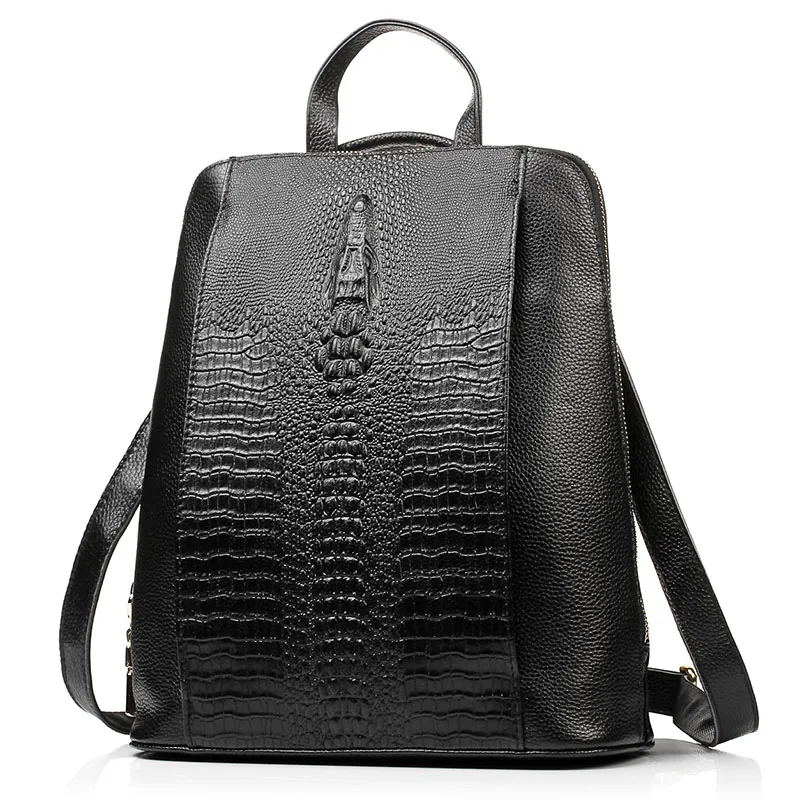
| Weight Category | Thickness | Ideal Applications |
|---|---|---|
| Lightweight | 2-4 oz (0.8-1.6 mm) | Interior components, linings, pockets |
| Medium | 5-7 oz (2.0-2.8 mm) | Bag bodies, non-load-bearing panels |
| Heavy | 8+ oz (3.2+ mm) | Straps, handles, reinforcement points |
For maximum durability, critical load-bearing components like straps and handles should be at least 8-10 oz (3.2-4.0 mm) thick. The main body of a durable bag typically requires 5-7 oz (2.0-2.8 mm) leather, providing adequate structure without excessive weight.
Finding the right balance between thickness and weight requires understanding the bag’s intended use. A daily commuter bag needs enough thickness to withstand constant handling but must remain light enough for comfortable carrying. Conversely, a travel duffel might prioritize thickness for maximum durability even at the cost of added weight.
When evaluating potential purchases, pay special attention to thickness at stress points—where handles connect to the body, along seams, and at the bottom of the bag. These areas experience the greatest force during use and require adequate thickness to prevent premature failure.
Construction Elements That Enhance Leather Durability
Even the finest leather will fail prematurely without proper construction techniques. The methods used to cut, stitch, and assemble leather bags dramatically impact their longevity, making construction quality just as important as material selection.
Stitching Techniques and Materials:
– Saddle stitching (two needles working through the same hole from opposite sides) creates redundant connections that won’t unravel even if one thread breaks
– Bonded nylon thread offers tensile strengths of 8-15 pounds per thread, far exceeding standard cotton threads
– Appropriate stitch density (5-7 stitches per inch) balances strength with minimal perforation
– Backstitching or bar tacking at stress points prevents seam failure
Hardware Considerations:
– Solid brass hardware resists corrosion and maintains structural integrity
– Stainless steel components offer maximum strength with minimal weight
– Quality hardware should be securely attached with backing washers that distribute stress
– Movable parts should articulate smoothly without binding or causing wear
Reinforcement Methods:
– Strategic use of rivets at high-stress junctions
– Leather reinforcement patches at wear points
– Edge reinforcement to prevent delamination
– Corner protection to minimize impact damage
The relationship between leather quality and construction technique is symbiotic—neither can compensate for deficiencies in the other. Understanding how construction details impact durability helps when evaluating whether full-grain leather is better for backpacks and other bags.
When examining a potential purchase, pay particular attention to these construction details, as they often reveal more about a bag’s likely lifespan than surface appearances alone.
Understanding Leather Finishes and Their Impact on Longevity
The finish applied to leather significantly impacts both its appearance and durability. These surface treatments serve both protective and aesthetic purposes, creating a crucial barrier between the leather’s natural fibers and environmental threats like moisture, UV radiation, and staining agents.
| Finish Type | Protection Level | Natural Appearance | Best Applications |
|---|---|---|---|
| Aniline | Minimal | Maximum (most natural) | Showcase pieces, low-exposure environments |
| Semi-aniline | Moderate | High (natural with some protection) | Everyday bags with careful handling |
| Pigmented/Finished | Maximum | Low (more uniform, less natural) | Heavy-use bags, adverse conditions |
Aniline Finish: This minimal treatment uses soluble dyes that penetrate the leather without forming a surface coating, allowing the natural grain and markings to remain fully visible. While aniline finishes preserve leather’s natural beauty and breathability, they provide minimal protection against water, stains, and UV damage. Aniline-finished bags require diligent care but will develop the most beautiful patina over time.
Semi-aniline Finish: Representing the middle ground, semi-aniline leather receives a light protective coating over the dyed surface. This thin finish offers moderate protection while still allowing much of the leather’s natural character to show through. For most premium bags, semi-aniline finishes provide an ideal balance between protection and natural beauty.
Pigmented/Finished Leather: These leathers receive substantial surface coatings that include pigments and protective polymers. While these finishes offer maximum protection against water, stains, and UV damage, they obscure much of the leather’s natural character and limit patina development. Heavily finished leathers excel in challenging environments but sacrifice some of leather’s natural beauty and aging characteristics.
The choice of finish directly impacts how a bag will age—aniline and semi-aniline finishes allow the development of rich patina that many leather enthusiasts prize, while heavily finished leathers maintain a more consistent appearance over time.
The Living Canvas: How Patina Enhances Durability and Beauty
Patina—the gradual transformation of leather’s appearance through use and exposure—represents one of leather’s most distinctive and desirable characteristics. Unlike synthetic materials that simply wear out, quality leather evolves over time, developing a unique character that tells the story of its journey with you.
Far from being merely cosmetic, patina actually enhances leather’s durability in several ways:
- Natural oils redistribute through handling, conditioning worn areas
- Surface oxidation creates a protective barrier against moisture
- Minor scratches blend into the overall character rather than standing out as damage
- The leather becomes more supple and resistant to cracking over time
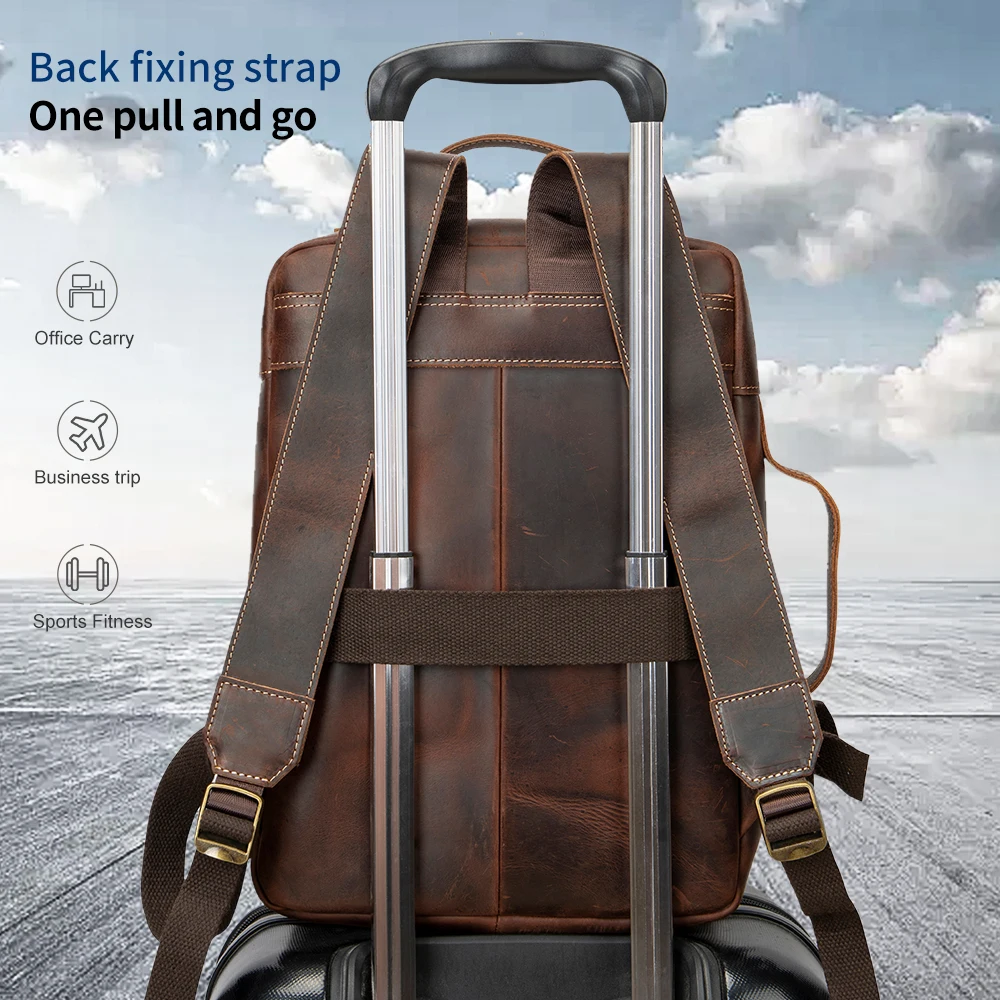
The most beautiful patina development typically occurs in full-grain, vegetable-tanned leathers. These materials change dramatically over time—often starting relatively light and developing rich, deep tones within the first year of use. By the five-year mark, well-cared-for leather develops complex color variations and a smooth luster that synthetic materials cannot replicate.
Common misconceptions about patina include confusing it with damage or premature wear. In reality, proper patina development enhances rather than degrades leather’s appearance and protective qualities. The darkening at flex points and edges, subtle color variation, and gentle burnishing effect all contribute to leather’s living finish.
To encourage positive patina development:
– Use the bag regularly—leather benefits from handling
– Apply appropriate conditioners that nourish without oversaturating
– Allow natural exposure to indirect light
– Embrace minor marks as contributions to character rather than flaws
Carry On Leather Backpack, Roll Top Leather Backpack
Price range: $77.76 through $96.48 Select options This product has multiple variants. The options may be chosen on the product page17 Inch Leather Laptop Backpack, Men's Leather Travel Backpack, Men's Leather Work Backpack
Price range: $106.28 through $143.88 Select options This product has multiple variants. The options may be chosen on the product pageLuxury Leather Backpack, Small Leather Backpack, Women's Leather Backpack
Price range: $137.48 through $138.28 Select options This product has multiple variants. The options may be chosen on the product pageDesigner Women's Backpack, Luxury Leather Backpack
Holographic Geometric Laser Diamond PU Leather Women’s Fashion Backpack with Glow-in-the-Dark Design$112.20 Select options This product has multiple variants. The options may be chosen on the product pageFull Grain Leather Backpack, Men's Leather Laptop Backpack, Men's Leather Work Backpack
$353.46 Select options This product has multiple variants. The options may be chosen on the product page15 Inch Leather Laptop Backpack, Carry On Leather Backpack
Price range: $136.84 through $139.88 Select options This product has multiple variants. The options may be chosen on the product page
Essential Care Practices for Maximizing Leather Bag Lifespan
Proper maintenance dramatically extends the lifespan of leather bags, transforming them from temporary possessions into lifetime companions. A consistent care routine addresses leather’s natural needs while preventing common issues that can shorten a bag’s useful life.
Basic Cleaning Routine:
– Remove surface dust and dirt with a soft, slightly damp cloth
– Clean more thoroughly with pH-neutral leather cleaner when needed
– Always test new products on an inconspicuous area first
– Allow thorough drying away from direct heat sources
Conditioning for Longevity:
– Apply appropriate conditioner every 3-6 months depending on use and climate
– Use conditioners that replace natural oils without oversaturating
– Pay special attention to stress points and flex areas
– Allow adequate absorption time before use
Environmental Protection:
– Store bags away from direct sunlight when not in use
– Avoid prolonged exposure to extreme temperatures
– Protect from rain when possible, but know that quality leather can handle occasional moisture
– Use appropriate waterproofing methods for leather bags in adverse conditions
Addressing Common Issues:
– Treat minor scratches by gently rubbing with a clean finger (natural oils help blend marks)
– Remove water spots by allowing complete drying then conditioning
– Prevent shape distortion by storing bags properly stuffed when not in use
– Address mold immediately with gentle cleaning and thorough drying
A proper maintenance schedule includes daily minor care (wiping down, proper storage), monthly attention (thorough cleaning, checking stress points), and seasonal deep care (conditioning, hardware maintenance). This graduated approach ensures problems are caught early when they’re easily addressable.
Choosing the Right Leather for Your Specific Needs
Selecting the optimal leather type requires balancing durability requirements against other practical considerations including weight, flexibility, appearance, and budget. Different use scenarios demand different leather characteristics for optimal performance.
For Daily Commuting and Professional Environments:
– Consider top-grain or full-grain leather with semi-aniline finish
– Look for medium thickness (5-6 oz) for balance of durability and weight
– Chrome-tanned or combination-tanned options offer good water resistance
– Professional environments may favor more refined grain patterns
For Travel and Outdoor Adventures:
– Prioritize full-grain leather with greater thickness (6-8 oz)
– Consider buffalo or reinforced cowhide for maximum durability
– Vegetable-tanned leather offers best long-term structural integrity
– Weather resistance becomes more critical—look for appropriate finishes
For Luxury and Special Occasions:
– Full-grain leather with minimal finish allows maximum character development
– Consider specialty leathers that offer unique aesthetic qualities
– Vegetable-tanned options develop the most distinguished patina
– Construction details like edge finishing become more important
Climate considerations should influence your choice as well. Humid environments benefit from chrome-tanned leathers with better moisture resistance, while dry climates may require more frequent conditioning of any leather type to prevent cracking.
When considering price, evaluate cost-per-use rather than just the initial investment. A $300 full-grain leather bag that lasts 15 years costs effectively $20 per year—often less expensive in the long run than replacing lower-quality bags every 1-2 years. This perspective on choosing quality leather bags helps justify the initial premium for better materials.
Are All Genuine Leather Labels Indicating Poor Quality?
The term “genuine leather” creates significant confusion in the marketplace. While technically a specific grade of leather (the split layer below top-grain), it’s often used more broadly as a marketing term simply indicating that a product contains real leather—without specifying quality.
This dual usage leads to inconsistent quality among items labeled “genuine leather.” Some manufacturers use this term specifically to indicate lower-grade split leather, while others (particularly in certain regional markets) use it simply to distinguish real leather from synthetic alternatives.
To look beyond this potentially misleading label, consider:
- Price as a quality indicator—genuine leather in its technical meaning costs significantly less than full or top-grain options
- Additional descriptive terms that might accompany “genuine” (full-grain, top-grain, etc.)
- Visual and tactile assessment of the leather’s characteristics
- The reputation of the manufacturer or brand
Common misleading alternative terms include “real leather,” “authentic leather,” and “pure leather”—all of which tell you only that the material comes from an animal hide, not where in the hide or how it was processed.
For maximum transparency, reputable leather goods makers typically specify exact leather types (full-grain, top-grain) rather than relying solely on the ambiguous “genuine leather” designation.
How Can You Tell If a Leather Bag Will Last?
Evaluating leather quality before purchase requires attention to specific details that indicate durability potential. These practical assessment techniques help ensure your investment will stand the test of time:
Visual Inspection Checklist:
– Look for tight, visible grain pattern indicating higher leather quality
– Check edge finishing—burnished or painted edges should be smooth and consistent
– Examine stitching for evenness, appropriate density (5-7 stitches per inch), and no loose threads
– Assess hardware attachment points for reinforcement
Tactile Assessment Techniques:
– Feel the leather’s weight and substance—quality leather has noticeable heft
– Bend the leather to test flexibility—it should flex without surface cracking
– Smell the material—quality leather has a distinctive natural scent (not chemical or plastic)
– Press a fingernail lightly into an inconspicuous area—quality leather will show slight marking that recovers
Questions to Ask Retailers:
– What specific type of leather is used (not just “genuine” or “real”)?
– What tanning method was employed?
– What is the leather’s country of origin?
– What is the thickness/weight of the leather used?
Red flags that suggest poor durability include:
– Extremely lightweight feel despite large size
– Perfect uniformity without natural variation
– Strong chemical smell
– Edges that appear layered or are peeling
– Plastic-like finish or unnaturally perfect surface
Is More Expensive Leather Always More Durable?
The relationship between price and leather quality follows a general correlation—higher prices often indicate better materials and construction—but this relationship isn’t absolute. Several factors influence pricing beyond just durability characteristics:
While premium full-grain leather typically commands higher prices due to its superior durability, other factors like brand positioning, manufacturing location, and design complexity also significantly impact final pricing. A mid-range bag from a manufacturer focused on quality craftsmanship may offer better durability than a high-end fashion brand prioritizing design over materials.
Understanding value requires looking beyond price tags to assess specific quality indicators. For example, a $200 bag using 6-8 oz full-grain leather with saddle stitching may offer better durability than a $500 designer bag using thinner top-grain leather with machine stitching.
Brand heritage sometimes justifies premium pricing through proven long-term performance. Manufacturers with decades of history producing durable goods have demonstrated their quality through countless real-world tests. However, newer brands committed to quality materials and construction can offer excellent durability at more accessible price points.
The most reliable approach is evaluating specific material and construction characteristics rather than assuming price alone guarantees durability. With the knowledge gained throughout this guide, you’re now equipped to look beyond marketing and make informed decisions based on the factors that truly determine leather durability.




